Situation Report – 02 January 2016
(Text only. To see photos on PDF file, click on the link at the bottom.)
CHRONOLOGICAL SUMMARY
- On 23 December, typhoon Nina became the 13th typhoon of the 2016 season. It was predicted by both the Japan Meteorological Agency (JMA) and the Philippine Atmospheric Geophysical Astronomical Services Administration (PAGASA) to westward/ westnorth westward track across the Bicol and Southern Tagalog regions.
- On 25 December, TY Nina made its first landfall over Bato, Catanduanes and second landfall over Sagnay, Camarines Sur. It was a Category 4 tropical cyclone when it made landfall with one-minute sustained winds of 260 kilometers per hour. The typhoon brought little rain but the winds damaged whole plantations of crops (see picture above).
- TY Nina made 6 additional landfalls over San Andres, Quezon; Torrijos, Marinduque; Verde Island, Tingloy Island, and Calatagan, all of Batangas; and Lubang Island, Occidental Mindoro.
- Tropical Cyclone Warning Signals were hoisted over 33 provinces in regions V (Bicol), CALABARZON, MIMAROPA, Central Luzon, Western, Eastern, and Central Visayas.
- A total of 192 passenger ships were stopped from leaving port while 337 domestic and 5 international flights were cancelled due to the bad weather conditions, resulting in thousands of stranded passengers.
- The provinces of Catanduanes and Camarines Sur declared a state of calamity due to the severity of the damage in both provinces. Twenty-one landslides were reported in Catanduanes on the national highway in the towns of San Miguel, Viga, and Gigmoto.
- The typhoon traversed the Philippine landmass and was declared out of the Philippine Area of Responsibility at 11:40 PM of 27 December 2016.
- The National Disaster Risk Reduction and Management Council (NDRRMC) reported that a total of 424,223 families (1,893,404 persons) in 1,698 barangays from regions V, VIII, CALABARZON and MIMAROPA were affected.
- Three people were reported dead and twenty-one missing due to typhoon-related incidents, including a ferryboat sinking.
- A total of 248,788 houses were damaged by the typhoon across the affected regions, 181,441 partially and 67,346 totally.
- Estimated cost of damages to agriculture was pegged at 121,697,999.10 pesos. Estimated cost of damages to infrastructure was estimated at 1,021,553,895.00 pesos.
- More data is being gathered from the ground by the regional centers via its disaster preparedness committees (DPCs).
PREPAREDNESS & MITIGATION ACTIVITIES
Preemptive evacuation was reportedly done in Tinambac, Camarines Sur a day before the typhoon hit. This mirrors the province-wide preparedness measures instigated by local disaster risk reduction and management offices. The Bicol region is noted for its excellent disaster awareness and preparedness.
The National Disaster Risk Reduction and Management Council (NDRRMC) has reported the preemptive evacuation of a total of 87,059 families (429,485 individuals) in the regions of CALABARZON, MIMAROPA, V (Bicol), and VIII (Eastern Visayas).
Additionally, the NDRRMC issued memorandum no. 82, which enjoined all local counterparts in areas affected by the typhoon to regularly monitor weather advisories, gale warnings, flood warnings, and severe weather bulletins. It also conducted a pre-disaster risk assessment at its operations center in Camp General Emilio Aguinaldo in Quezon City via video conferencing with its local offices.
All of the regional centers under the Citizen’s Disaster Response Network (CDRN) would be affected by typhoon Nina were on alert status as early as December 21. The following were advised to activate preparedness measures such as community-based early warning systems and office and staff safety: Alay Bayan-Luson Inc. (ABI); Community Response for Enlightenment, Service, and Transformation (CREST); Southern Tagalog People’s Response Center (STPRC); Tarabang para sa Bikol Inc. (TABI); and Leyte Center for Development, Inc. (LCDE). The #CDRC and CDRN Emergency Protocol Structure was activated and closely monitored the typhoon’s track and movement.
Stand-by emergency relief assistance funds (ERAF) from Diakonie Katastrophenhilfe were prepared for possible release to TABI, LCDE, and STPRC. LCDE prepositioned goods ready for distribution. The Asia Pacific Alliance for Disaster Management (A-PAD) had prepositioned non-food items at the TABI office. Meanwhile, CDRC partner CARE Philippines committed funds for damage, needs, and capacities assessment (DNCA) and initial relief delivery to LCDE, TABI and STPRC. Oxfam Philippines also committed to support CDRC’s DNCA in Bicol. CDRC and its Regional Centers also prepared and placed on standby its psychosocial teams trained under the American Jewish Joint Distribution Committee (JDC) and the Israel Trauma Coalition (ITC).
Efforts may be also coordinated with those of CDRC’s co-convenor under A-PAD, the private sector network Philippine Disaster Resilience Foundation (PDRF), and the Disaster Risk Reduction Network Philippines (DRRNet Phils).
CURRENT SITUATION
At the moment, the following areas have been declared by their respective Local Government Units (LGUs) in a state of calamity:
Information received by the network from its disaster preparedness committees (DPCs) in Camarines Sur, Quezon province and Calapan City, Mindoro revealed that a sizable number of families have lost their houses to the typhoon. See details in the following table.
Table 1. Damage to Infrastructure
After the typhoon made landfall December 25, the electricity grid in the provinces of Catanduanes, Camarines Sur, Albay, and Sorsogon were cut off. Electricity was restored to the Bicol urban centers of Naga and Legazpi only on December 31, almost a week after. Water supply in remote barangays was also cut off. In Barangay Catanusan, Minalabac, Camarines Sur, water sources were believed compromised by flooding, with cases of diarrhea and vomiting noted. Many areas near the Bicol River remain submerged.
Other infrastructure and facilities notably damaged were 11 schoolbuildings, 13 roads and bridges, and the domestic airport in Virac, Catanduanes,
Meanwhile, the same community-based disaster preparedness committees were first to report to CDRN and the municipal disaster risk reduction and management office (MDRRMO) the number of evacuees now in various evacuation centers in both Bicol and MIMAROPA areas under the watch of network members Tarabang para Bicol Inc. (TABI) and Southern Tagalog People’s Response Center (STPRC).
In Tinambac, Camarines Sur, 23 affected barangays were reported. A total of 4,661 families (25,051 individuals) were monitored in evacuation centers. However, an additional 3,332 families (18,024 individuals) were listed as affected outside the evacuation centers. Municipal Disaster Risk Reduction & Management Office head Romil Estolan provided the data to CDRC and A-PAD Philippines country coordinator Marion Ramirez. See following table for more information.
Table 2. Number of Evacuated Families
The provinces of Catanduanes and Camarines Sur top the most number of evacuees. In an update issued December 27, the National Disaster Risk Reduction and Management Council (NDRRMC) reported that 145 schools with 477 classrooms were used as evacuation centers. Barangay halls and gyms were also used. However, in many areas, evacuees were still drenched in rain and subjected to high winds that blew off the roofs of evacuation centers.
The NDRRMC peds the total damage nationwide wrought by the typhoon at roughly 5 billion pesos. At the local level, damage to agriculture was reported by the Catanduanes PDRRMO at over 215 million pesos, with the most damage to abaca crops at 192 million and coconut at 13 million. Camarines Sur comes in with a bigger cost of damage, at over 1 billion pesos, most notably caused by the devastation of its rice and corn crops. See details in Table 3.
Table 3. Damage to Agriculture
HUMANITARIAN RESPONSE
I. From Government
The Department of Social Welfare and Development (DSWD) has called for volunteers to help the 35 AFP personnel deployed in the repacking of relief goods in its national warehouse in Chapel Road, Pasay City. It has already started relief delivery operations in affected areas in Catanduanes.
According to the NDRRMC, a total of Php 7,109,686 was approved for relief assistance by the DSWD to the provinces of Albay, Camarines Sur, and Sorsogon in Region V. Apart from the relief operations, the Office of Civil Defense provided hot meals to stranded passengers in Abra de Ilog port in Mindoro. In Poctoy port, the Coast Guard provided meals to stranded passengers.
A total of 7,993 families or 43,075 individuals have been given relief assistance in Tinambac, Camarines Sur. The Catanduanes PDRRMO reported that 6,780 families or 16,333 individuals have been given food packs, or 34.62% of the total number of evacuees (19,579 individuals).
II. From CDRN & Partners
LCDE and TABI have sent out rapid assessment teams to ascertain damage and needs of the affected population in their respective areas. The teams also conducted an initial delivery of relief goods. In the pictures in this section, LCDE staff conduct an inventory of the prepositioned goods and a pre-relief briefing for its staff.
CDRC, with its partner regional center TABI conducted rapid damage assessments in eleven barangays in the worst-hit provinces in Bicol, namely Albay, Camarines Sur, and Catanduanes. STPRC also conducted rapid assessments in South Quezon and Marinduque, the most affected provinces in the Southern Tagalog Region.
Initial relief delivery operations were conducted in five barangays and served a total of 945 families. See Table 4 for details.
Table 4. Relief Distributed
Relief operations from funds coming from Diakonie Katastrophenhilfe and Action Medeor are scheduled for January 2017. Funding is still being sought after the damage assessments revealed the needs of the affected communities.
IDENTIFIED NEEDS
Based on the damage assessments, different needs were identified for the affected communities. The CDRC-TABI teams conducted the assessments in the most remote and least served barangays and came up with the following table.
Table 5. Identified Needs of Affected Communities
The PDRRMO of Camarines Sur also issued a call for rehabilitation assistance, particularly for the construction of resilient houses to at least 50% of the families who suffered total damage to their houses. They also appealed for the construction of evacuation centers in the coastal barangays of Lagonoy, Presentacion, Sangay, Caramoan, Garchitorena, Siruma, Balatan, San Fernando, Pasacao, and Cabusao.
Other severely affected provinces are that of Albay, Marinduque, Quezon and Mindoro. CDRC will continue to update this SitRep as data comes in.
Download PDF file: SitRep6_TYNina_01022016
CDRC and CDRN Contact Persons
- Suyin Jamoralin, CDRC Executive Director, 0977-849-6279, info@cdrc-phil.com
- Malen Serato, CDRC Research and Public Information Department, 0916-499-1410, rpid@cdrc-phil.com
- Cora Jazmines, CDRC Local Partnership Department, 0949-845-1271, lpd@cdrc-phil.com
- Ana Avillanosa, STPRC Executive Director, 09284209546, stprc96@gmail.com
- Cris Biñas, TABI Executive Director, 0977-4296033, tarabang@yahoo.com
- Jazmin Jerusalem, LCDE Executive Director lcde1988@yahoo.com
Data Sources:
- Damage, Needs, Capacities Assessment (DNCA) from grassroots communities in Bicol & Southern Tagalog
- MDRRMO of Tinambac, Camarines Sur
- https://en.wikipedia.org/wiki/Typhoon_Nock-ten_(2016)
- http://www.philstar.com/headlines/2016/12/26/1656927/typhoon-nina-makes-eighth-landfall-over-lubang
- https://www.facebook.com/PAGASA.DOST.GOV.PH/?fref=ts
- Southern Tagalog People’s Response Center (STPRC)
- http://www.ndrrmc.gov.ph/
- Leyte Center for Development (LCDE)
- Tarabang para sa Bikol Inc. (TABI)
- PDRRMO Catanduanes
- PDRRMO Camarines Sur

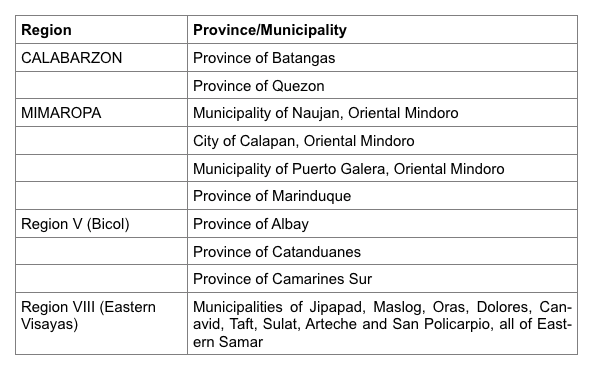
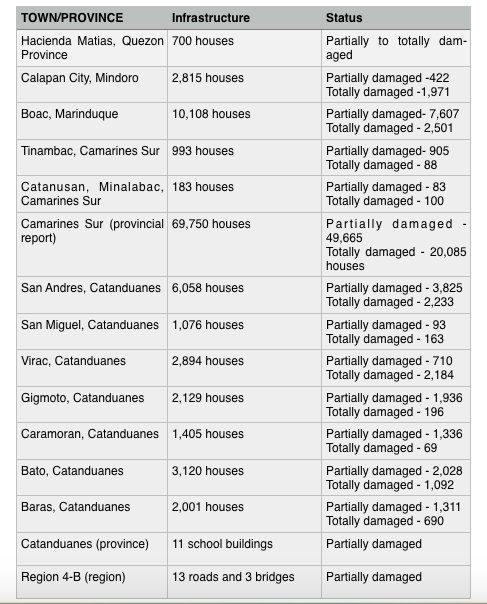
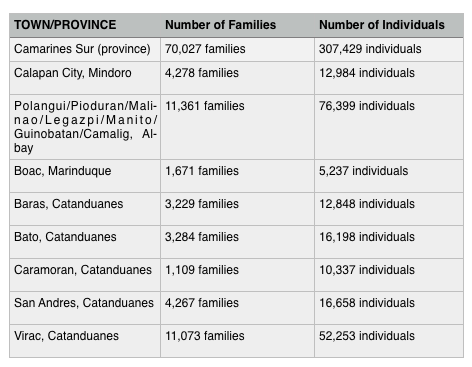
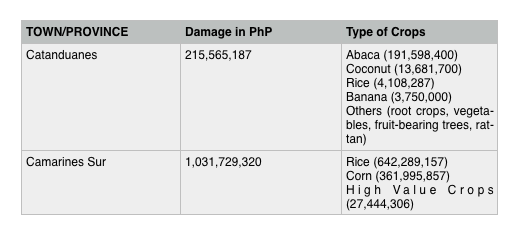
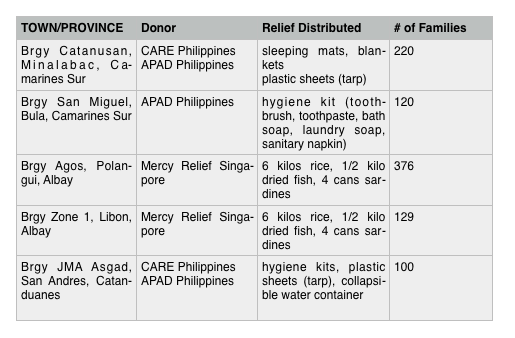
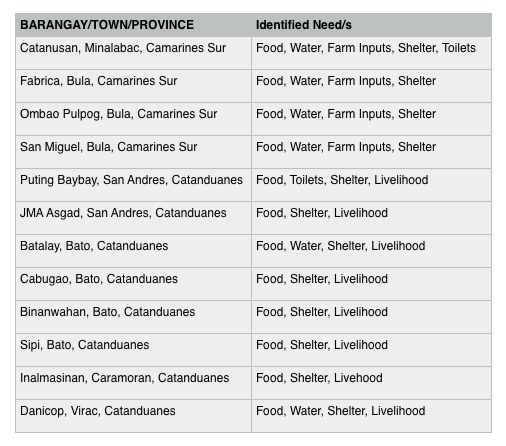
Leave a Reply